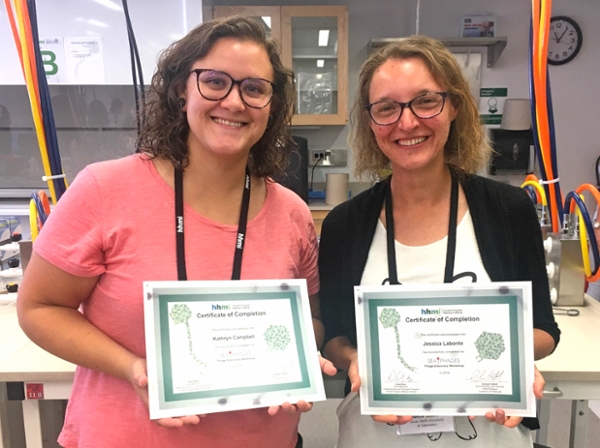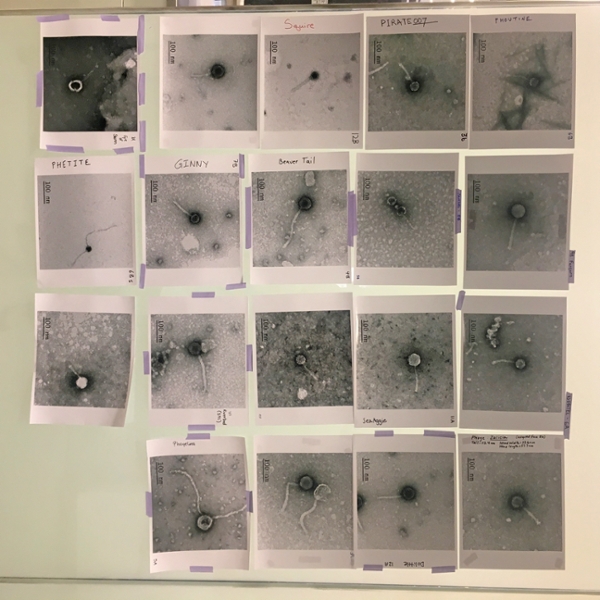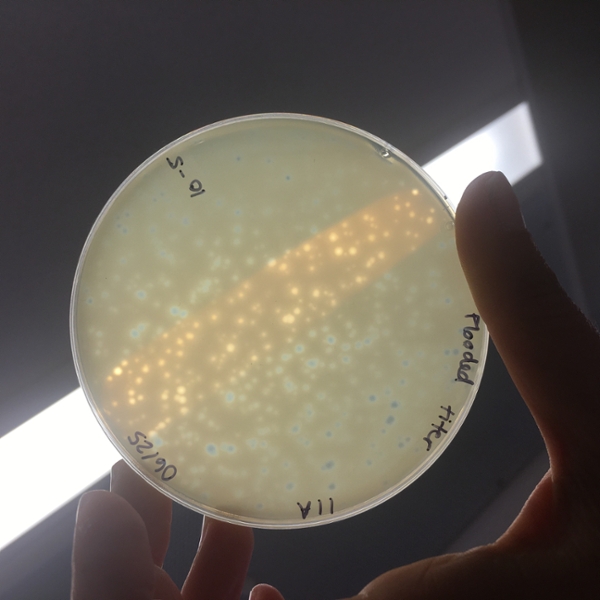New A&M-Galveston Class Elevates Freshman Learning in the Lab
September 25, 2019
Tweet
Graduate student Kate Campbell and Dr. Jessica Labonté of the Texas A&M University at Galveston Viral Ecology Laboratory proudly display their certificates of completion at the end of the SEA-PHAGES Discovery workshop, held in Baltimore June 23-28, where they were trained to teach the course.
By Patrick Temperilli, Marketing and Communications
Dr. Jessica Labonté, Assistant Professor in the Department of Marine Biology at Texas A&M University at Galveston, will be teaching an innovative new course this fall, SEA-PHAGES (Science Education Alliance-Phage Hunters Advancing Genomics and Evolutionary Science). The course will aim to take ten freshmen students and give them the opportunity to get intensive lab time and learning that is otherwise reserved for more senior students.
“It’s designed for freshman which is not an opportunity that a lot of freshmen get, to work in the lab and have their own project from the get-go,” Labonté said. “They’ll learn how to become a scientist, which is what a lab should be about.”
Each student will have their own project which will consist of collecting a soil sample, isolating a bacteriophage (a virus infecting a bacteria). While all the students will have the same bacteria, each virus will be unique. Students will isolate their phage, purify it, study and characterize its DNA, photograph it, and name it. Each phage will then be entered into the national database, PhageDB.
There are 118 schools throughout the country that are participating in this program, which originated 12 years ago with Graham Hatful at the University of Pittsburgh and with the Howard Hughes Medical Institute.
Students will make a presentation to their peers to show what their virus is capable of, and in the second semester two will be sent for DNA sequencing. The genomes will be analyzed in the second part of the course, taught in the Spring. One student will get to go to the annual symposium in Ashburn, Virginia in June, where everybody from the participating schools come together and discuss the results of their research.
Labonté’s role with this course is a natural fit given her expertise in environmental microbiology and her passion for innovative teaching and learning opportunities. She’s also keenly aware of the growth possibilities with such a course.
“At the end of each semester they have to fill out a survey,” Labonté said. “And that survey will see how they feel, the psychological outcomes of the program. And there are a few papers that show that overall students were way more confident in their abilities and that the majority of them realized that science was good for them, that it’s what they wanted to do for their career. Instead of theory all the time, the hands-on part was really exciting for them.”
With every virus being unique, some students may move through their project at a different pace than their peers, but they’ll still be able to get the same lessons out of the experience. “They’re all going through the same techniques,” Labonté said. “There’s detailed protocols. Everyone is following the same methods.”
Given that the program will be in its first year at TAMUG, Labonté is pleased with the smaller numbers and the more hands-on approach it will allow her to have. “If it’s a success, hopefully I can add more faculty members next year. I’ve only heard good things from other schools,” she said.
Labonté is keeping an eye on the bigger picture, and believes this program will have a positive effect that extends well beyond the classroom. “I think that for the university, it may help with student retention,” Labonté said. “I think it will boost the student’s confidence in general, because even if they don’t want to do microbiology, they will have the confidence to go work in other labs.”
“They will know how to handle a pipette, how to maintain a lab book, how to manage their time so they can finish things, and these are all skills that can be used in any of the labs that are here,” Labonté said. “I hope that it will encourage them to contact other faculty to work in their lab. I’m going to have the students make a class poster for the TAMUG symposium, so they can practice making a poster and talk about their experience and get to see the other research that’s going on around here.”
“With this class, they may not know what they want to do but they’ll have the confidence to go and ask around. And they’ll know how to actually do research. For me, that is what’s important. Some of them may even get a publication out of it, which is rare as an undergrad, and as a freshman even rarer. And even if they don’t like it, at least they will know.”
“This can only be good,” Labonté said. “I’m excited.”

A display of all the phages that were isolated by the SEA-PHAGES instructors during the SEA-PHAGES Discovery workshop.

A Petri dish showing isolated phage plaques, visible structures formed within a cell culture. Each clear zone was formed because the bacteriophages killed the bacteria on a lawn of cells.
###